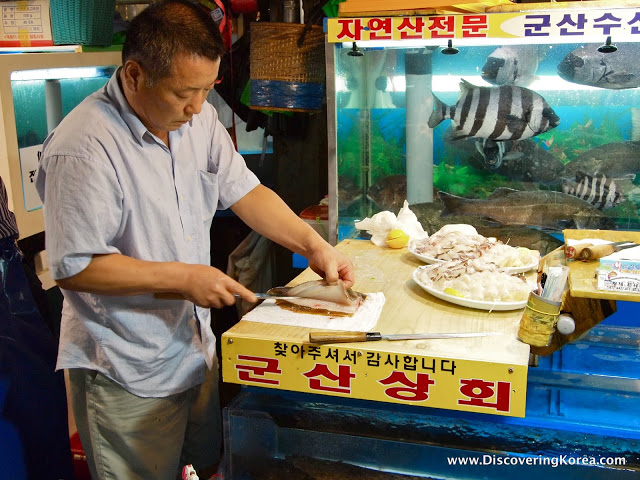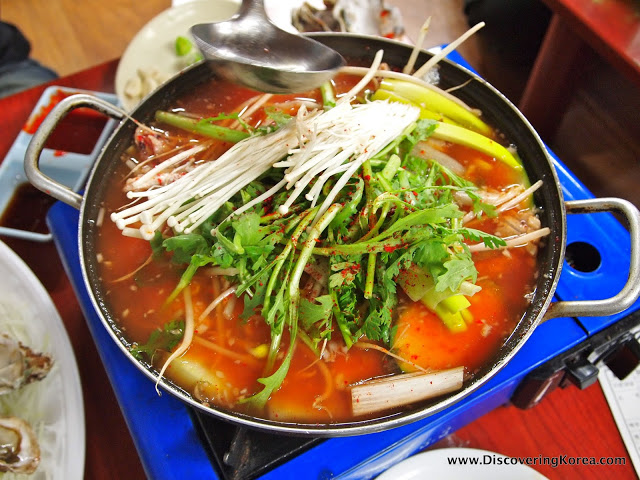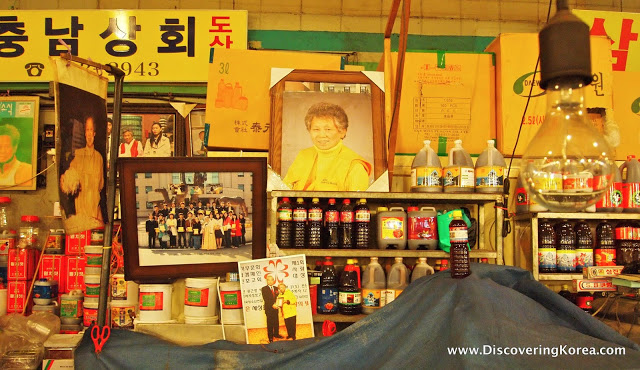A fresh, briny smell emerges about halfway across the overpass that connects Noryangjin Station (노량진역) to the roof of a weathered warehouse. After turning left into a stairwell and descending two flights, you’ll see long rows of fish tanks stacked three and four high.

Brimming with sea creatures familiar and exotic, the Noryangjin Fisheries Wholesale Market (노량진수산시장) showcases a diversity of marine life befitting a nation surrounded by the sea.
At hundreds of stalls, squid caught off Ulleungdo island lay prostrate beside prized gulbi from Yeonggwang County. Imported Russian pollock and Canadian lobster add international flavor.
While the scallops, oysters and rows of spooning prawns may look familiar, the tanks also feature bizarre, local delicacies. Monggae, a fluorescent orange sea squirt has roots on one end and rubbery spikes on the other.

Taken as a whole, the Noryangjin Fisheries Wholesale Market is a striking contrast to the antiseptic neighborhood grocery store. In fact, a gullible visitor could be forgiven for thinking this wasn’t a market at all, but some kind of rustic aquarium.
Instead, Noryangjin Fisheries Wholesale Market is Korea’s largest wholesale fisheries market.
Established in 1927 and relocated to the south bank of the Hangang river in 1971, the market serves 30,000 daily customers and supplies 40 percent of greater Seoul’s seafood. Each year, market operators estimate sales of 300 billion Korean won ($280 million).
To process this extraordinary volume, the market is a 24-hour operation. While most Seoulites are fast asleep, at one o’clock AM a raucous, members-only auction begins on the warehouse’s second floor.

Retail sales follow on the main level, where 700 fishmongers and fishwives rise at four AM to start their 18-hour day.
Lest those long hours standing in cold and damp conditions suggest otherwise, Jang Hong-gun loves his job. The 20-year Noryangjin Fisheries Wholesale Market veteran says the only downside is being too busy.
His stall, #106, occupies a choice spot on the market’s main aisle. During the peak spring and fall seasons, a good day he’ll sell 200 fish, on a bad one less than 10.

Whatever the volume, customer transactions usually follow a consistent script. A fish is selected from the tanks and a price is quoted. Cleverly, negotiations are conducted while the fish gasps in Jang’s hands, creating urgency.
Market rates are already about 20-to-30 percent lower than you’ll find elsewhere, but a feisty customer can haggle away another 10 percent. Ultimately, an average-sized flounder runs about 20-to-25,000 won.

If cooking fish this fresh seems almost heretical, Jang will turn your “catch” into a platter of hwae, or Korean-style sashimi set atop shredded cabbage.
To this end, his stall includes a wood counter stocked with Spartan supplies – knives, Styrofoam plates and a large roll of plastic wrap. As he deftly cleans, skins, de-bones and slices the fish, I ask him for the secret of fish prep.
Eyes fixed on the fillet he pauses momentarily, and then resumes with a succinct reply, “Everyone has their own style. I can’t explain it in words. For me it’s in the movement.”

Minutes later, Jang’s wife, Kim In-soon, escorts the platter downstairs to Jungang Sikdang (중앙식당), one of a dozen-or-so seafood restaurants located inside the market.
For a flat fee of just 3,000 won per head, diners receive a wicker basket filled with lettuce and sesame leaves as well as several condiments – hot pepper paste, soy sauce, raw slices of garlic and chili peppers.
Kim says Jungang boasts the market’s best maeuntang, a spicy seafood stew made from vegetables and your fish’s carcass. Indeed, the fiery broth adds some kick to complement the fish’s subtle flavor. But for a different kick altogether, locals typically order a bottle of Korea’s favorite firewater, soju.

Hunger satiated, there should be one more pit stop on your Noryangjin Fisheries Wholesale Market itinerary. Although the market is best known for fresh seafood, its northwest end specializes in jeotgal.
These salted and fermented seafood pastes are used as flavoring and to pickle kimchi. Among the vendors is Ryu Yang-seon. The indefatigable 79-year-old is known as “the books grandmother” for using her profits to fund textbooks and over 150 scholarships for needy students.

Spending a few minutes with Grandma Ryu or fishmonger Jang inevitably raises questions. Why do we shop at so-called “super”-markets when traditional and specialty markets like Noryangjin Fisheries Wholesale Market are usually cheaper and more fresh?
After all, in addition to being a fun and delicious way to spend a few hours, Noryangjin’s 4,000 merchants, mongers and wholesalers help reconnect us with our food.
What’s more, few experiences can capture Korea’s vibrancy as an evening spent at one of Seoul’s bustling marketplaces.
For Your Information..
| Open: | 24 hours. |
| Price: | Depends on vendor and purchase. Prices typically 20-30% cheaper than retail. |
| Address: | Dongjak-gu Noryangjin 1(il)-dong 13-8 |
| Directions: | Noryangjin Station (#136/#917) on Lines 1 & 9, Exit 2 |
| Phone: | 02-987-1010, 02-815-8416 |
| Website: | Official Site |
About Matt Kelley
Matt Kelly is native of the US Pacific Northwest and is half-Korean by ethnicity. He lived in Korea for five years and has written hundreds of travel guides for Wallpaper, TimeOut, the Boston Globe and Seoul Magazine and was a host for several different variety shows on Korean radio and television.
